Embark To Hari Parbat In Kashmir For A Refreshing Break In 2026

Nestled atop the lush Hari Parbat Hill, the Hari Parbat in Kashmir is a remarkable testament to the region’s storied past. This iconic fortress, commanding panoramic views of Srinagar, invites travellers to delve into its historical depths and architectural splendour. Constructed during the Mughal era and later enhanced by local rulers, the fort offers a unique glimpse into Kashmir’s rich cultural heritage. As you wander through its ancient corridors and robust walls, you’ll uncover the layered history of Hari Parbat in Kashmir, making it an essential destination for history enthusiasts and adventure seekers alike.
Hari Parbat Fort History

Visiting the Hari Parbat Fort is one of the most exciting experiences that shed light on the history of the Kashmir region. There are many myths associated with its construction. It is known that the fort was built in the 16th century using the local Mughal architectural style. Constructed on the Hari Parbat Hill, originally home to ancient temples and monasteries, the fort was built under the orders of Jahangir, son of Emperor Akbar.
While exploring the majestic walls and internal yards of the Hari Parbat Fort, you will learn more about the place, its historical background from the Mughal Empire, and the multicultural fabric of the state. This makes it a perfect destination for tourists who prefer historical sites, as this building gives them a feel of the region’s history.
Also Read: Places To Visit In Kashmir
Hari Parbat Fort Timings
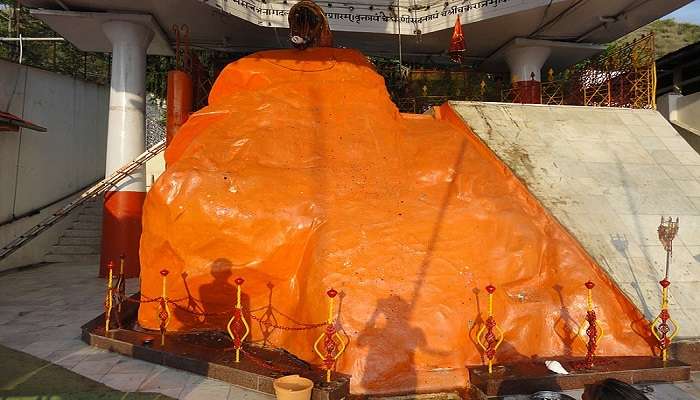
Hari Parbat Fort is open for tourists throughout the year and has visiting hours between 9 AM and 5 PM, so tourists may spend considerable time watching the fort and the beautiful scenery of Srinagar.
It is advised to visit the place in the morning as the fort might attract many tourists during the afternoon. Do not forget to consult local timetables and possible changes or closures, for example, during festivals or bad weather, so your visit will run smoothly.
Hari Parbat In Kashmir Shrines
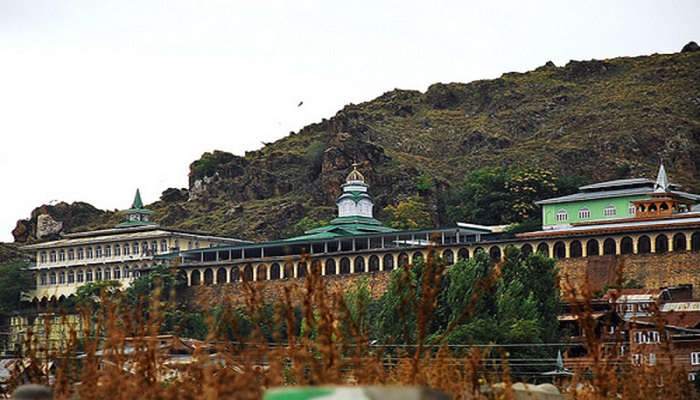
Located on the Hari Parbat Hill, the shrines of Kashmir give an exciting insight into the unique rituals in the region. While strolling through this site, you will come across the Shankaracharya Temple, which is dedicated to Lord Shiva and offers an eye-pleasing view of Srinagar. Visitors can also use this route to Kherbawari Temple, and there are many other Muslim shrines, indicating the Sufi influence of the region.
Each shrine is a calm place where several religions coexist in the Kashmir valley, and the peace that is felt while strolling through the beautiful gardens still echoes. However, to experience the tranquility and history infused within the heart of Kashmir, you can always venture into the Hari Parbat in Kashmir shrines.
Related Post: Festivals In Jammu And Kashmir
Hari Parbat InKashmir: Popular Attractions Nearby
Nearby attractions include the serene Dal Lake, where visitors enjoy shikara rides amid stunning mountain views. Like Shalimar and Nishat Bagh, the enchanting Mughal Gardens showcase Mughal-era grandeur with their beautiful terraces and fountains. The sacred Hazratbal Shrine, an influential Muslim pilgrimage site, lies on the northern shores of Dal Lake, while Shankaracharya Temple, perched atop a hill, provides both spiritual solace and breathtaking city vistas.
1. Mughal Gardens

Within easy commuting distance of Hari Parbat, Srinagar’s Mughal Gardens of Shalimar Bagh, Nishat Bagh, and Chashme Shahi display Mughal gardening. These gardens have paved terraces with flower displays and fountains in historical surroundings that can be a great place to walk. Every one of the gardens, in some way or another, sheds a little light on the art of horticulture in the areas under the control of the Mughals. Being an epitome of love, Shalimar Bagh, also known as ‘Shalimar Garden’ was laid by the Emperor Jahangir for his wife Nur Jahan. The largest one is Nishat Bagh, literally meaning the Garden of Joy, which will provide you with stunning views of Dal Lake and mountains. Chashme Shahi is a natural spring that is famous as the Royal Spring, and people believe that the water of this spring has some sort of healing power.
Timing: 9 AM – 7 PM daily
Entry Fee: INR 30 per person for Indian tourists, INR 50 for foreign tourists
Address: Srinagar, Jammu and Kashmir, India
2. Shankaracharya Temple
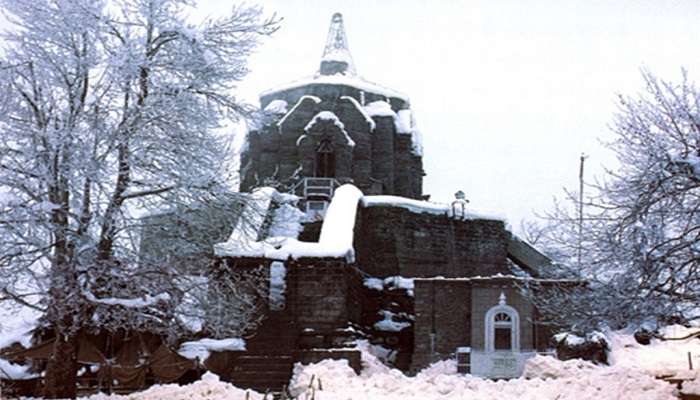
Perched atop Shankaracharya Hill, this ancient Hindu temple offers breathtaking panoramic views of Srinagar and the Dal Lake. Dedicated to Lord Shiva, it is an architectural gem on a 20-foot-tall octagonal base. Inside, you can find a small circular chamber housing a Shivalinga encircled by a snake. One needs to climb around 243 steps to reach the temple, but the surrounding view and the spiritual vibe are worth experiencing. The temple’s serene setting and historical importance make it a must-visit for spiritual seekers and history enthusiasts alike.
Timing: 6 AM – 8 PM daily
Entry Fee: Free
Address: Shankaracharya Hill, Srinagar, Jammu and Kashmir, India.
Related Post: Restaurants In Srinagar
3. Dal Lake
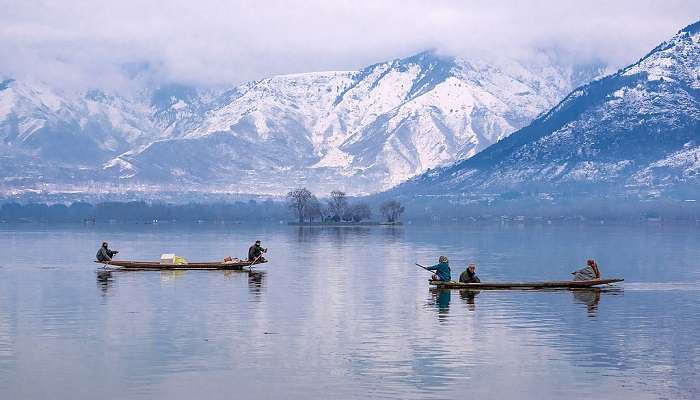
This iconic attraction is everyone’s favourite, whether you’re a family vacationer, honeymoon couple, or solo traveller. The lake is renowned for its breathtaking vistas of lofty rolling hills and the distant snow-capped mountains, which create a serene and picturesque backdrop. The canopied Shikaras gliding gracefully across the water offer a unique and tranquil experience, while the floating gardens add a touch of natural beauty that is both enchanting and mesmerising. The intricately crafted houseboats made of wood, with their traditional Kashmiri decor, provide an immersive stay that transports you into the heart of the region’s rich cultural heritage. Whether you’re seeking relaxation or adventure, Dal Lake offers something for everyone, making it a must-visit destination in Kashmir.
Timing: 6 AM – 6 PM daily
Entry Fee: None (Shikara rides cost extra)
Address: Srinagar, Jammu and Kashmir, India
4. Jamia Masjid
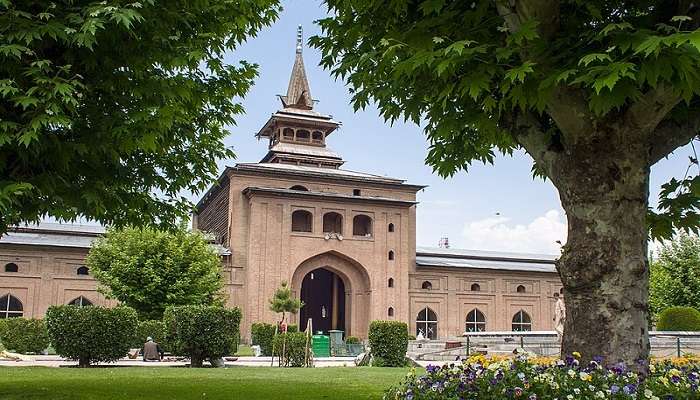
This mosque is one of the oldest and most beautiful structures with an arched roof, attracting many tourists to the valley. Jamia Masjid is a peaceful place with a large courtyard, 378 wooden columns, and a magnificent view of the Himalayas. The mosque is visited and appreciated by people of all religions and tourists. The Minarets and turrets of the mosque are Buddhist pagoda style, and the hypostyle hall has Persian influence. Other features that make this place even more interesting include a carved ceiling, a sloping roof and the gardens surrounding the mosque.
Timing: 7 AM – 7 PM daily
Entry Fee: None
Address: Nowhatta, Srinagar, Jammu and Kashmir, India
Related Post: Best Hotels In Kashmir
5. Hazratbal Shrine
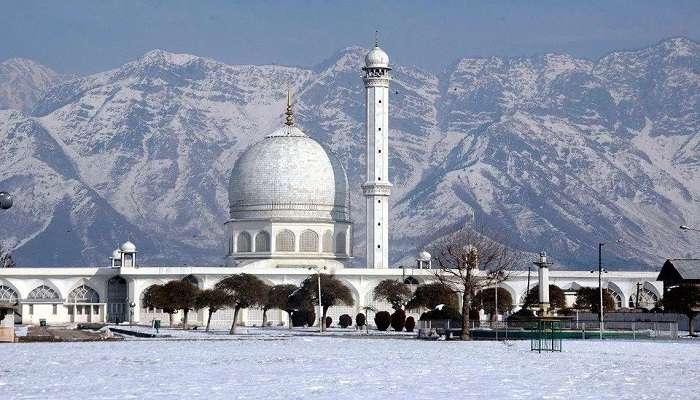
This sacred silvery-white Muslim shrine is said to contain the hair strand of Prophet Muhammad, which is brought before the general public only on specific occasions. The shrine is not a holy place of worship but a visually striking attraction on Dal Lake’s banks. Considered the only domed mosque in Srinagar, Hazratbal Shrine’s scenic location and spiritual significance make it a must-visit place in the region. Besides seeking blessings, visitors can enjoy a peaceful boat ride on Dal Lake for ultimate relaxation.
Timing: 9 AM – 5 PM daily
Entry Fee: None
Address: Hazratbal, Srinagar, Jammu and Kashmir, India
How To Reach Hari Parbat In Kashmir
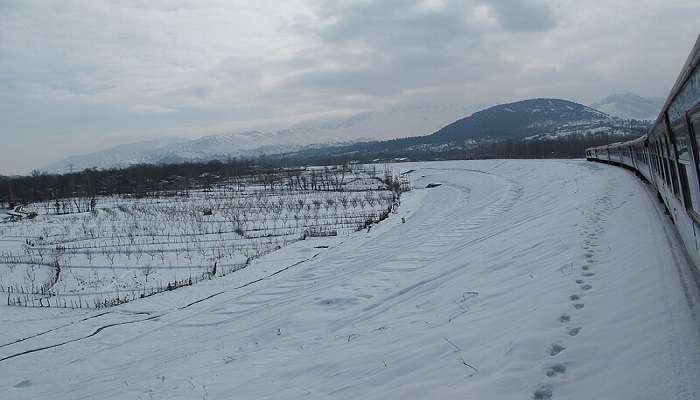
Getting to Hari Parbat in Kashmir is not challenging, and everyone finds the journey adventurous. It is situated in Srinagar and can be reached by car in about fifteen minutes or by walking if one wants to discover the area. Your tour starts by travelling in the direction of Dal Lake; one can easily hire a local taxi or self-drive to reach the foothills of Hari Parbat.
For a more relaxed approach, one can walk through the colourful markets of Srinagar, which will take you straight up to the bottom of the hill. Here, a tiny climb is to be made to reach the fort and the famous Hari Parbat Temple on the top of the hill.
You May Also Like To Read: Things To Do In Kashmir In June
Travelling to heaven on earth, specifically the Hari Parbat Kashmir, will give you the best breathtaking view and provide a history lesson. Srinagar’s skyline and layout can be viewed with a bird’s eye view from the Hari Parbat Hill on which the fort stands. The cultural and historical importance of kashmir becomes perhaps visible and meaningful when you tread the ancient walls of this place and the attractions around it. So book a trip to Kashmir and explore this enchanting place.
For our editorial codes of conduct and copyright disclaimer, please click here.
Cover Image Credit: M.khannn for Wikimedia Common
Frequently Asked Questions About Hari Parbat In Kashmir
What is the best time to visit Hari Parbat Fort?
Early morning, when the weather is cool and pleasant, is the best time to visit Hari Parbat Fort. The mosque is crowded on Fridays and during peak tourist season.
Is there an entrance fee for visiting Hari Parbat Fort?
No, there is no entrance fee to visit Hari Parbat Fort. It is open to locals and visitors, allowing ample opportunity to relax amid breathtaking vistas.
How much time is needed to explore Hari Parbat Fort?
It typically takes 1 to 2 hours to explore the fort, walk through the courtyards and soak in the panoramic views.
Are any facilities available at Hari Parbat?
Basic facilities like drinking water and restrooms may be available. However, it is best to carry your supplies, especially water bottles and some snacks.
Can I take photographs at Hari Parbat?
Yes, photography is allowed at Hari Parbat, but please respect religious sites and follow any specific guidelines provided at the temples or shrines.
People Also Read:
Shopping In Kashmir Valleys In Kashmir Lakes In Kashmir

Unveil the hidden treasures of the globe and turn every travel dream into reality. As a Content Writer, I am passionate enough to craft stories from ancient wonders to modern marvels. My words paint the picture-perfect itinerary for unforgettable experiences. Let my words be your trusted guide to immerse in the diverse culture and discover the beauty of the unknown.











